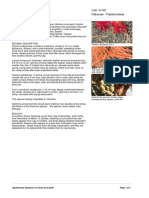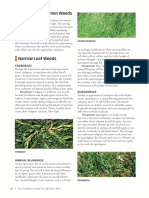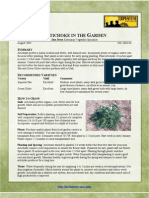Spear Thistle Fact Sheet
Spear Thistle Fact Sheet
Uploaded by
sandy barCopyright:
Available Formats
Spear Thistle Fact Sheet
Spear Thistle Fact Sheet
Uploaded by
sandy barOriginal Description:
Original Title
Copyright
Available Formats
Share this document
Did you find this document useful?
Is this content inappropriate?
Copyright:
Available Formats
Spear Thistle Fact Sheet
Spear Thistle Fact Sheet
Uploaded by
sandy barCopyright:
Available Formats
Pest Plant Local Law
Spear Thistle
Note Number: PPLL 10
Spear Thistle (Cirsium vulgare)
Spear Thistle is an annual / biennial broadleaf weed
growing to 1.5 metres. It is a highly invasive weed of
improved pasture where it favours fertile soils with high
levels of nutrients. It is also a common weed of bushland
areas, cultivated areas, roadsides and disturbed / waste
sites, especially in moist areas. When established, it
crowds out most plants by shading and competition for
nutrients and water.
Spear Thistle is avoided by livestock because of its spines Spear thistle rosette of spiny leaves
and overgrazing of paddocks encourages its spread. Stems
If eaten, the spines can cause damage to stock, particularly
Stems are erect with spiny wings along the length.
around the mouth. Dried leaves and spines can contribute
Commonly several stems emerge from the base, but can
to the contamination of wool fleeces which can incur a
be a single stem.
price penalty at markets.
Seeds
Local Scene Seed is grey / light-brown, with a tuft of bristles attached:
Spear Thistle is widespread in the City of Whittlesea. It up to 2.5 cm long. Up to 200 flower heads and 8000 seeds
favours the basalt soils in the west of the municipality can be produced per plant.
where it commonly grows with Artichoke and Variegated Roots
Thistles. It is more widely distributed than other thistle
Plants develop a taproot with numerous branches.
species and is a common weed in the higher rainfall areas
of Humevale, Whittlesea and Kinglake West.
Life Cycle / Reproduction
Identification and Description Spear Thistle reproduces by seed and grows by a one or
two-year life cycle depending on when seeds germinate.
Flowers The main germination occurs after the first autumn rains
Purple flowerheads up to 5 cm in diameter are born with some emergence in late winter to spring. Plants die
singularly or in groups of 2-3, and are surrounded by spiny after flowering and can remain standing for 1-2 years.
bracts. Summer flowering (December to February). Seed is relatively heavy and is only dispersed a short
distance by the wind from the parent plant. Seed can be
dispersed long distances in contaminated hay because
plants are normally flowering when hay is cut. Seed
remains viable for a relatively short time in the soil.
Spear Thistle in flower
Leaves
Leaves are dark green to 35 cm long and deeply divided.
They are prickly on the upper surface giving them a hairy Previous seasons’ dead Spear Thistle plants
appearance. Leaves end with a distinct yellow stout spine.
Initially develops as a rosette of leaves at ground level.
DISCLAIMER: The advice contained in this publication is intended as a source of information only. Always use chemicals in accordance with manufacturer
directions on the product label or in Material Safety Data Sheets available from the manufacturer. The City of Whittlesea and its officers do not guarantee
that the publication is without flaw of any kind or is wholly appropriate for your particular purpose and therefore disclaims all liability for any error, loss or
other consequence which may arise from your relying on this information
Control and Management Chemical Control
Clean areas should be kept free of Spear Thistle and Spot spray infestations using a chemical registered for
managed to prevent infestation. Lightly infested areas Spear Thistle.
should be prioritised to prevent further establishment and Use a broadleaf specific herbicide to avoid off-target
prevent spread. Heavily infested areas should be tackled damage to surrounding desirable pasture grasses.
progressively over a number of years. Treat at the rosette stage. Mature plants with
Prevention flowering stems are difficult to kill due to a well-
established tap root.
Beware of source infestations- seed can be
Long-term control
transported in contaminated soil, in soil attached to
rock and imported in hay. Ensure you have good coverage of perennial grasses,
Avoid overgrazing paddocks with stock as this will crops or native vegetation.
remove the competition provided by pasture grasses. Limit soil disturbance and monitor treated areas for
Controlling rabbits will remove selective grazing re-infestation.
pressure that will favour Spear Thistle establishment Remove as soon as identified.
and spread.
Remove individual plants as soon as identified.
Similar native species
Maintain competitive groundcover to prevent
establishment. There are no similar native species
Non-chemical control
Further Information
Seedlings and small plants can be chipped out when at
the rosette stage. Take care to ensure all root material This factsheet should be read in conjunction with Note
is removed. PPLL 12- Weed Control Techniques.
Cultivation is effective in killing the plant but must be Contact Council’s Land Management and Biodiversity
undertaken as a preliminary action prior to the Team for further information and assistance on the
establishment of competitive pasture or crops. control of this weed on 9217 2147
Slashing plants is only effective once flowers are
produced otherwise plants will reshoot. Be cautious,
as viable seeds may already have been produced if
flowers are present when cutting occurs.
Seasonal Guide to the Management of Spear Thistle
SUMMER AUTUMN WINTER SPRING
Dec Jan Feb Mar Apr May Jun Jul Aug Sep Oct Nov
Hand removal Spot spraying Cultivation
DISCLAIMER: The advice contained in this publication is intended as a source of information only. Always use chemicals in accordance with manufacturer
directions on the product label or in Material Safety Data Sheets available from the manufacturer. The City of Whittlesea and its officers do not guarantee
that the publication is without flaw of any kind or is wholly appropriate for your particular purpose and therefore disclaims all liability for any error, loss or
other consequence which may arise from your relying on this information
You might also like
- Vanilla Handbook TablecontentsDocument2 pagesVanilla Handbook Tablecontentsjacji50% (2)
- Lesson Plan For Science 3 (Second Quarter)Document6 pagesLesson Plan For Science 3 (Second Quarter)Dinah Dimagiba100% (1)
- Weeds in Banyule BookletDocument52 pagesWeeds in Banyule Bookletswazza2007No ratings yet
- Asparagus: CultivarsDocument3 pagesAsparagus: CultivarsLukaNo ratings yet
- Staghorn Ferns For FloridaDocument4 pagesStaghorn Ferns For FloridaNguyễnThanhHùngNo ratings yet
- Weeds and Weed ManagementDocument13 pagesWeeds and Weed ManagementAndrew MarariaNo ratings yet
- Stinging Nettle: Integrated Pest Management PrescriptionDocument2 pagesStinging Nettle: Integrated Pest Management PrescriptionRobert Fetch100% (1)
- Fern Propagation Report 2018 - AmaDocument18 pagesFern Propagation Report 2018 - AmaCharmyne De Vera SanglayNo ratings yet
- Snake WeedDocument3 pagesSnake WeedUssi AffilaterNo ratings yet
- KudzuDocument6 pagesKudzuDonovan WagnerNo ratings yet
- Watermelon Farming Ecological Requirements AltitudeDocument8 pagesWatermelon Farming Ecological Requirements AltitudeWangari Lothaire RachealNo ratings yet
- PG EcvuDocument4 pagesPG Ecvuamiralak255No ratings yet
- Brochure ChivesDocument2 pagesBrochure ChivesdaisykumbirayimunyatiNo ratings yet
- Poison Hemlock Management PamphletDocument1 pagePoison Hemlock Management Pamphletbecky.criderNo ratings yet
- Erythrina AbyssinicaDocument5 pagesErythrina AbyssinicaEvolys Digital IncNo ratings yet
- Management of Verticillium Wilt of OliveDocument4 pagesManagement of Verticillium Wilt of OliveAhmed Shek HasanNo ratings yet
- Eggplant Production (Simple)Document8 pagesEggplant Production (Simple)Jesanro AmaranteNo ratings yet
- rubber-vineDocument6 pagesrubber-vineankit bhattNo ratings yet
- Aw22jwjehwsparagusjjhhbbuu71919191933 in The GardenDocument3 pagesAw22jwjehwsparagusjjhhbbuu71919191933 in The GardenRed DiggerNo ratings yet
- Celery TN 2020Document3 pagesCelery TN 2020Fursey WhyteNo ratings yet
- Guia Identificacion TetragonaDocument4 pagesGuia Identificacion TetragonaleinadNo ratings yet
- Lawn CareDocument47 pagesLawn CareNguyễn Hoài ThuNo ratings yet
- Common Weeds: IdentifyingDocument15 pagesCommon Weeds: IdentifyingJavier AlbujaNo ratings yet
- Beans in The GardenDocument3 pagesBeans in The GardenJuan Manuel Herrera NavasNo ratings yet
- Nut TrsDocument4 pagesNut TrscantorNo ratings yet
- What Is Potato Blight V5Document12 pagesWhat Is Potato Blight V5mikeNo ratings yet
- GraftingDocument10 pagesGraftingtxungoNo ratings yet
- Cassava and Yam Production and Management TecnoguideDocument16 pagesCassava and Yam Production and Management TecnoguideEric D. ValleNo ratings yet
- How Plants GrowDocument2 pagesHow Plants Growbeatrizisa2901No ratings yet
- TN691 Plants Planting MethodsDocument6 pagesTN691 Plants Planting MethodsRamroop SinghNo ratings yet
- FPMGT C7Document13 pagesFPMGT C7Angelyn RodulloNo ratings yet
- Multiflora RoseDocument2 pagesMultiflora RoseKenNo ratings yet
- Early Blight: World Vegetable CenterDocument2 pagesEarly Blight: World Vegetable CenterPreet MaanNo ratings yet
- Ampalaya: Farmer Factsheet - IpmDocument6 pagesAmpalaya: Farmer Factsheet - IpmMarjunex PedrosoNo ratings yet
- Flea Beetles On Vegetables: (Coleoptera: Chrysomelidae)Document8 pagesFlea Beetles On Vegetables: (Coleoptera: Chrysomelidae)narendraNo ratings yet
- Artichoke in The GardenDocument2 pagesArtichoke in The GardenCharlesNo ratings yet
- Fs 106Document3 pagesFs 106ealbertolopezNo ratings yet
- Gardening Without Harmful Invasive Plants: A Guide To Plants You Can Use in Place of Invasive Non-NativesDocument27 pagesGardening Without Harmful Invasive Plants: A Guide To Plants You Can Use in Place of Invasive Non-NativesbaakicaaNo ratings yet
- Creeping Thistle: Successful Control in Organic FarmingDocument8 pagesCreeping Thistle: Successful Control in Organic FarmingGregory BakasNo ratings yet
- Adventist Youth Honors Answer Book Outdoor Industries Flower CultureDocument11 pagesAdventist Youth Honors Answer Book Outdoor Industries Flower CultureSimple DaddyNo ratings yet
- Managing For Native Pollinators - Small Scale Solutions For Your FarmDocument4 pagesManaging For Native Pollinators - Small Scale Solutions For Your FarmgreenkinaturalNo ratings yet
- 1848 Ha 99Document17 pages1848 Ha 99Leonides Bernardo Fernández LicónNo ratings yet
- Flowering Bulb Insect Pests Control Gardening Guidebook For South CarolinaDocument3 pagesFlowering Bulb Insect Pests Control Gardening Guidebook For South CarolinaWinter GardeningNo ratings yet
- Landscape and Ornamental: Flower Garden PestsDocument6 pagesLandscape and Ornamental: Flower Garden PestsMarkNo ratings yet
- Prosopis Juliflora AZT™', AZT™' Native MesquiteDocument2 pagesProsopis Juliflora AZT™', AZT™' Native MesquiteMara LiceoNo ratings yet
- Pollinator Gardens USDADocument8 pagesPollinator Gardens USDAinfoNo ratings yet
- Syringa Reticulata Japanese Tree Lilac: Fact Sheet ST-610Document4 pagesSyringa Reticulata Japanese Tree Lilac: Fact Sheet ST-610Alain RatataNo ratings yet
- Purdue ExtensionDocument4 pagesPurdue ExtensionmdollNo ratings yet
- Josephs Coat Plant: How To Grow and Care For AlternantheraDocument9 pagesJosephs Coat Plant: How To Grow and Care For AlternantheraColeen AlidoNo ratings yet
- Avocado DiseasesDocument7 pagesAvocado DiseasesHo Thanh CanNo ratings yet
- Cultivation of Common CropsDocument6 pagesCultivation of Common CropsRomeo Dionisio CorporalNo ratings yet
- Kentucky Pest News April 3, 2012Document8 pagesKentucky Pest News April 3, 2012awpmaintNo ratings yet
- Asexual Plant PropagationDocument4 pagesAsexual Plant PropagationEdgardo DelleraNo ratings yet
- Hele 6 - Week 3Document9 pagesHele 6 - Week 3blueliteNo ratings yet
- Prop PlantsDocument4 pagesProp PlantsshaunaNo ratings yet
- Okra in The GardenDocument3 pagesOkra in The Gardenndiwa mulovhedziNo ratings yet
- Top Ten Pests in Indiana and How To Control ThemDocument2 pagesTop Ten Pests in Indiana and How To Control Themapi-249697193No ratings yet
- Agri ReportDocument43 pagesAgri Reportrieann leonNo ratings yet
- Crown of Thorns ProductionDocument2 pagesCrown of Thorns ProductionDdoa TandlianwalaNo ratings yet
- Weeds ScienceDocument47 pagesWeeds ScienceDanica Lao-ayNo ratings yet
- Narra Information PaperDocument2 pagesNarra Information PaperKhaelNo ratings yet
- Plant RootsDocument8 pagesPlant RootsAndreaaAAaa TagleNo ratings yet
- GPB 355 Printed Long Note 2Document107 pagesGPB 355 Printed Long Note 2kalulalupatidar00No ratings yet
- Class 7 Bio Heterotrophic Nutrition in Plants Part B New 1624717471Document5 pagesClass 7 Bio Heterotrophic Nutrition in Plants Part B New 1624717471Darshan PadmapriyaNo ratings yet
- 15 The Plant WorldDocument5 pages15 The Plant WorldnishantNo ratings yet
- Chase 1952Document5 pagesChase 1952László SágiNo ratings yet
- Abstract Book - Novi-Sad2014Document25 pagesAbstract Book - Novi-Sad2014bosiokNo ratings yet
- FUNARIADocument25 pagesFUNARIAIzzy ChanNo ratings yet
- 2122 Course Revision Science Grade 3 Term 1 - No AnswerDocument7 pages2122 Course Revision Science Grade 3 Term 1 - No AnsweranwarNo ratings yet
- Traditional Medicinal Uses of Mosses: ArticleDocument10 pagesTraditional Medicinal Uses of Mosses: ArticleSwagsyde AfricaNo ratings yet
- Denr - v9 Bamboo PDFDocument22 pagesDenr - v9 Bamboo PDFJake VillaNo ratings yet
- Mucuna BracteataDocument4 pagesMucuna BracteataIsya ApriliyanaNo ratings yet
- Peppers in The Garden PDFDocument4 pagesPeppers in The Garden PDFTafara GwarindaNo ratings yet
- Living Things RevisionDocument7 pagesLiving Things RevisionSyed Mujahid AliNo ratings yet
- The Seed Plants II. Angiosperms: Major Reference: Plant Systematics by Michael Simpson Various UrlsDocument65 pagesThe Seed Plants II. Angiosperms: Major Reference: Plant Systematics by Michael Simpson Various UrlsJBNo ratings yet
- Swertia Chirayita 2023Document10 pagesSwertia Chirayita 2023Bandhan ThapaNo ratings yet
- Cambridge Reading 18Document7 pagesCambridge Reading 18MM Imdadul KayesNo ratings yet
- 1st Cot New NormalDocument10 pages1st Cot New NormalAprilyn Miguel50% (2)
- Guide For EC PDFDocument17 pagesGuide For EC PDFLEON CAMPUSNo ratings yet
- Plant Nutrition QuestionsDocument2 pagesPlant Nutrition QuestionsPrakashdev99No ratings yet
- Dispersal - of - Seeds - by - Various - Agencies (Mohan) FinalDocument21 pagesDispersal - of - Seeds - by - Various - Agencies (Mohan) FinalKishore Notty100% (2)
- Carleton 1968Document4 pagesCarleton 1968Abdelghani BouchyouaNo ratings yet
- Effect of Seed Treatment On Seedling Health of Chili: M. Z. Alam, I. Hamim, M. A. Ali, and M. AshrafuzzamanDocument5 pagesEffect of Seed Treatment On Seedling Health of Chili: M. Z. Alam, I. Hamim, M. A. Ali, and M. Ashrafuzzamanyasir majeedNo ratings yet
- Reproductive Biology of AngiospermDocument6 pagesReproductive Biology of AngiospermSarojiniNo ratings yet
- Catch-Up 011224Document17 pagesCatch-Up 011224MJ CamzyNo ratings yet
- Efektivitas Fusarium Oxysporum F. Sp. Cepae Avirulen Dalam Mengendalikan Penyakit Layu Fusarium Pada CabaiDocument12 pagesEfektivitas Fusarium Oxysporum F. Sp. Cepae Avirulen Dalam Mengendalikan Penyakit Layu Fusarium Pada CabaiMuhammad ilhamNo ratings yet
- Seed Technology Protocol 2022 - White Nato - ArangenDocument8 pagesSeed Technology Protocol 2022 - White Nato - ArangenEarl Joseph TinamisanNo ratings yet
- Lesson 4 Types of Crops 1Document38 pagesLesson 4 Types of Crops 1Àigelo ÁmirNo ratings yet
- 2006 - Reinhard Agerer - Fungal relationships and structural identity of their ectomycorrhizaeDocument41 pages2006 - Reinhard Agerer - Fungal relationships and structural identity of their ectomycorrhizaeNéstor Orozco SuárezNo ratings yet

























































































